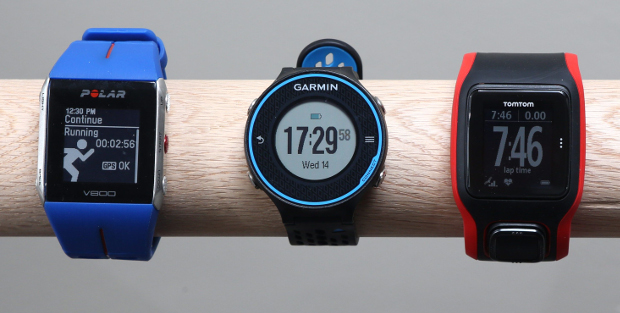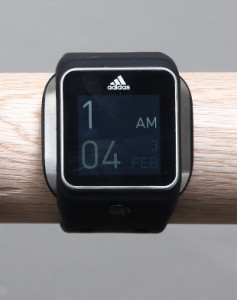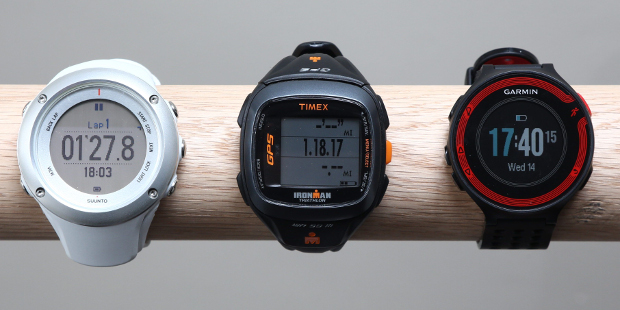New GPS Running Watches

Which running watch is the perfect training companion for you?
Adidas Smart Run
$400 We’ve had a chance to use the Smart Run since its release last year. This watch remains exciting for two significant reasons: it ushered in what we think will be the new standard in heart rate monitoring and it is essentially a small tablet on your wrist. Adidas is now dragging their competition into an era of chest-strap free heart monitoring, and that alone makes this watch groundbreaking.
The Smart Run is indeed intelligent – its software sports an open api, meaning programmers can build new apps for it just as they do for a smartphone. It’s also the only running watch on the market that can act as a Bluetooth music player.
But is the Smart Run a wise training buddy? It delivers the most accurate heart rate monitoring of any watch we’ve ever tested. Its custom programmable screens are pretty to look at and provide all the on-the-fly data you’ll need during a long run. Our testers had reservations with Adidas’s heavy reliance on the touchscreen, however. The watch only has one physical button, and many of the touchscreen features are tiny and tough to push while doing hard intervals. The analogy that the Smart Run is the Cadillac of GPS watches is apt, as you would probably want a Corvette for your track repeats. That said, if you’re more of a set-it-and-forget-it runner and you love a very powerful
gadget, the Smart Run is a great choice.
[column col=”1/3″]
Suunto Ambit 2S
$545 The Ambit 2S is Suunto’s newest GPS offering. It’s handsome, with a quartz mineral crystal and a brushed steel bezel. It’s a subtle variation on its sibling, the Ambit 2. The 2S is more focused on endurance sports, doing away with needless features for most runners, such as the barometric altimeter. Users can build and personalize their own apps with Suunto’s software and the 2S can run five at once. The 2S also has extensive cycling and swimming functions. It has a shorter battery life than the Ambit 2 due to its slimmer and lighter design, which is a welcome trade-off for most runners, but it still is bulky.
The accompanying chest heart rate monitor is among the most comfortable on the market and the GPS connects very quickly. The multiple info options and the high resolution screen are nice touches. The Ambit 2S does just about everything in addition to looking and feeling good on a larger wrist, making it a sound choice for those in need of a fully featured GPS watch. It is a pricey training solution, but Suunto’s recent partnership with Strava creates the potential for this luxury training companion to be well worth the investment.
[/column]
[column col=”1/3″]
Timex Ironman Run Trainer 2.0
$325 Although Timex has a superb legacy with sports watches, the timekeeping company has struggled to put out a leading GPS running product. Their last running unit had some significant problems, but the Run Trainer 2.0 was built to address those issues. For the most part, it has done just that.
First, the Run Trainer 2.0 is slimmer and has an updated design that brings Timex into the modern era of running watch design. The unit is also ant+ compatible, meaning that you don’t have to buy the optional heart rate chest strap if you’ve already got one.
Timex has also made a big effort to improve the accuracy of their GPS. The previous version frustrated our testers, but the Run Trainer 2.0 did a much better job at delivering trustworthy numbers. Another nice update is the nutrition reminders, where you can program in alerts for taking fluids and nutrition while on a long run.
For the price point, Timex has arrived at a running watch design that provides full bang for your buck. It also has biking and swimming functionality. The Ironman brand earns its reputation back with the Run Trainer 2.0.
[/column]
[column col=”1/3″]
Garmin Forerunner 220
$280 ($340 with HRM) Garmin’s mid-range unit delivers almost everything a runner could want in a running watch. The 220’s chassis is basically the same as Garmin’s premium training buddy, the 620, with a few minor design differences and fewer features under the hood. The 220 does not utilize touchscreen technology (as the 620 does, albeit sparingly), but this is a good thing. Touchscreens often backfire for runners during a sweat fest and the four button setup on the 220 may seem antiquated, it does the trick just fine.
Our testers struggled to find faults with the 220. It hits the right price point and comes preloaded with a GPS unit that locates satellites within just a few seconds. The colour screen is vibrant and slick. One minor concern that our testers mentioned was with the feel of the new Forerunner series build. Both the 220 and the 620 are extremely light (which is always a positive) but they feel almost toy-like. We have had a 620 in our office for many months and have yet to have an issue with its construction.
Garmin, who are often the industry leader with GPS watch technologies, have yet to embrace the built-in optical heart rate monitor, meaning that you’re stuck with a chest strap for this generation of the Forerunner series. But these minor criticisms can be forgiven when considering the incredible power of the 220. Add to that Garmin’s robust Garmin Connect platform and you’ve got an exceptional value.
[/column]
[column col=”1/3″]
Polar V800
$500 ($560 with HRM) The V800 is a bold step for Polar. Our testers enjoyed its core running features, including a virtual training partner, accurate GPS and custom programmable screens. The unit also handles swimming and biking data, but we stuck to the running aspect of the V800 for this review.
The watch is on the large side, but is really comfortable and even our smaller testers didn’t find it cumbersome. It’s made with brushed metal and feels sturdy. The buttons are subtle and can be tough to locate on the fly, but feel nice to the touch. All of our testers indicated that they loved the look and feel of the V800. Polar has also stuck with a chest heart rate monitor. The monitoring was accurate and, coupled with Polar’s geocaching of multiple recent locations, the watch is ready to roll almost immediately after you step out the door.
Another coup for Polar is that they’ve baked in a very robust fitness tracker into the V800 so that you don’t have to wear a separate unit to get other info from your daily life. Linking up to the Polar Flow website gives you all kinds of options for crunching the data and studying your energy output, be it from your last workout or last night’s sleep.
[/column]
[column col=”1/3″]
Garmin Forerunner 620
$450 When we first got our hands on the 620 we declared it to be one of best running watches we’d ever tested. That claim still stands after months of rigorous testing. This is Garmin’s premium offering and it has all the extras one would expect, including customizable multiple data screens, cadence, vertical oscillation, Vo2 Max and amount of ground contact.
The Forerunner 620 ups the ante by integrating a robust coaching feature that crunches all that data, giving feedback on workouts and even forecasting goal race times, as well as prescribing the proper amount of rest. With all these features, we were pleasantly surprised by the substantial battery life and featherlight presence of the watch on the wrist.
Like its little sibling the 220, the 620’s drawbacks are the lack of integrated HRM and the feel of the construction. We can attest that the build quality is top notch, as our tester models have gone through thousands of kilometres and one harsh Canadian winter and are still functioning perfectly. If you’re looking for a watch that can do just about everything a runner would desire, and you don’t mind the price tag, this is the watch for you.
[/column]
[column col=”1/3″]
TomTom Cardio
$300 TomTom steps up its game by adding one significant feature to its already decent running watch: wrist heart rate monitoring. The optical sensor is baked in to the watch, beaming a green light into your arm, taking a pulse from your capillaries. We found it to be accurate, although the watch needs to be very tight on the wrist to get a constant reading, but the soft, rubbery strap is comfy.
What we liked best about this watch is its simplicity. TomTom have boldly stuck with one button that does it all. It’s easy to configure and use, connecting to satellites within just a few seconds and delivering accurate pacing and distance results. It charges quickly and the battery life is substantial – a one-hour run took less than 10 per cent of the power.
The Cardio is well positioned at its price point to be a very attractive option. It comes preloaded with a virtual training partner, workouts and a treadmill option. Although TomTom does provide both a mobile app and training website, we found the latter to be very basic. Many runners want to dig deep into the data that these watches now provide and the MySports site only provides the basics: pace, heart rate, calories burned, elevation, stride rate and a mapped graphic of your route. The upside is that the data can be uploaded to other, more geeky services for all you number-crunchers out there.
[/column]




